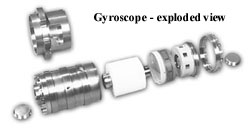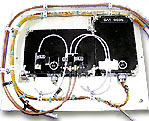Servicing
Mission 3A Overview
STS-103
on Space Shuttle Discovery, landed at 7:01 EST, Monday, December
27, 1999, 12:01 am GMT, December 28, 1999.
Mission Elapsed Time: 7 days, 23, hours, 10 minutes.
Launch Date: 7:50 pm EST, December 19, 1999; 12:50 am, GMT
December 20, 1999.
STS-103 Launch/Landing Opportunities
The
failure of a fourth gyroscope on November
13, 1999 placed Hubble in safe
hold until the SM3A rendezvous and grapple on December
20, 1999.
|
|
Servicing
Mission 3A successfully replaced equipment and performed maintenance
upgrades to the Hubble Space Telescope. Although no new scientific
instruments were installed, many activities took place over
3 EVA days. The originally
planned 4 days of EVA were changed to 3 days because of the
weather-delayed launch. The deorbit time was fixed for this
mission in order to avoid any possible Y2K problems.
Listed below are a few of the main activities that have taken
place.
More
Mission Information
Mission
Objectives
Mission
Success Criteria (pdf) (text
only)
Media Guide
Hubble Fact Sheets
Servicing Mission Launch Times
Hubble
Highlights
What
was Installed
 |
Advanced
Computer:
The new main computer is 20 times faster with six times
more memory than its predecessor. This computer, which
was successfully tested aboard STS-95 in 1998 on the HOST
mission, will dramatically increase capabilities, reduce
maintenance, and significantly lower operational costs.
|
Aft
Shroud Latches Repair Kit (ASLRK): This
kit will fix door latches in the aft shroud area that have been
damaged by extreme temperature changes and high torques. (Planned
but not installed because of the shortened mission)

Fine
Guidance Sensor (FGS):
Hubble uses three Fine Guidance Sensors for steady pointing
and measurement. Astronauts will exchange one of these optical
sensors with a refurbished unit that has enhanced, on-orbit
alignment capability. The new unit is a refurbished version
of the one that was returned from Servicing Mission 2 in 1997.
The unit it replaces will be refurbished and reinstalled during
Servicing Mission 4 in 2003.
Handrail
Covers: Fiberglass fabric, called beta cloth,
will be fitted like sleeves around the handrails above the Fine
Guidance Sensor bay. These covers prevent possible contamination
to the Aft Shroud area from flaking handrail paint.
New
Outer Blanket Layer (NOBL):
The NOBL consists of stainless steel panels covered with a protective
thermal coating. These panels fit over existing, degraded insulation
on Hubble's exterior surface, to control Hubble's internal temperature.
In 1997, astronauts on Servicing Mission 2 discovered damaged
areas of insulation and performed temporary repairs. The NOBL
will be permanently mounted. (Planned
but only partially installed because of the shortened mission)
 Gyroscopes
(Rate Sensor Units):
The gyroscopes are part of Hubble's pointing system. They
provide a frame of reference for Hubble to determine where
it is pointing and how that pointing changes as the telescope
moves across the sky. They report any small movements of the
spacecraft to Hubble's pointing and Control System computers.
The computers then command the spinning reaction wheels to
keep the spacecraft stable or moving at the desired rate.
The gyroscopes work by comparing Hubble's motion relative
to the axes of the spinning masses inside the gyroscopes.
In the absence of external torques, these axes remain stable
relative to the fixed stars in the sky. By keeping Hubble
fixed relative to these axes, Hubble stays stable relative
to the stars. Gyroscopes
(Rate Sensor Units):
The gyroscopes are part of Hubble's pointing system. They
provide a frame of reference for Hubble to determine where
it is pointing and how that pointing changes as the telescope
moves across the sky. They report any small movements of the
spacecraft to Hubble's pointing and Control System computers.
The computers then command the spinning reaction wheels to
keep the spacecraft stable or moving at the desired rate.
The gyroscopes work by comparing Hubble's motion relative
to the axes of the spinning masses inside the gyroscopes.
In the absence of external torques, these axes remain stable
relative to the fixed stars in the sky. By keeping Hubble
fixed relative to these axes, Hubble stays stable relative
to the stars.
Each
gyro contains a spinning wheel inside a sealed cylinder. This
cylinder is immersed in a thick, motor-oil-like fluid. Fine,
hair-like wires, surrounded by this thick fluid, carry electricity
to the motor.  Oxygen
pressurized air, used to force the thick fluid into the float
cavity which contains these wires, has corroded the wires
and caused them to break. Pressurized nitrogen, used in the
new gyroscopes, will eliminate the introduction of corrosive
oxygen. Oxygen
pressurized air, used to force the thick fluid into the float
cavity which contains these wires, has corroded the wires
and caused them to break. Pressurized nitrogen, used in the
new gyroscopes, will eliminate the introduction of corrosive
oxygen.
Hubble
has a total of six gyroscopes grouped in pairs inside three
Rate Sensor Units (RSUs). They are arranged in such a way
that any three gyroscopes can keep Hubble operating with full
accuracy. At the end of Servicing Mission 2, all six gyroscopes
were working normally. From January 1999 until November 13,
1999, Hubble had been operating with only 3 functional gyroscopes,
making it highly desirable to restore the remaining three.
Now that there are only two functional gyroscopes remaining,
Hubble is in safe-hold
mode and the science program has been suspended until the
completion of Servicing Mission 3A.

S-Band
Single Access Transmitter (SSAT): This
replacement transmitter uses radio waves to send data to the
ground. The older unit it replaces will be returned to Earth
and refurbished for a later flight.
Shell/Shield
Replacement Fabric (SSRF):
The SSRF consists of sheets of flexible, aluminized Teflon®
fabric that fit over the original Multi-Layer Insulation on
Hubble's forward shell and light shield to add thermal protection.
In 1997, astronauts on Servicing Mission 2 discovered damaged
areas of insulation and performed temporary repairs. The SSRF
will be permanently mounted over these temporary coverings.
(Planned but not installed)
 |
Solid
State Recorder(SSR) Installation:
Hubble's original data recorders were mechanical, reel-to-reel
tape recorders with many moving parts that wear out over
time. The digital SSR has no moving parts or tape to break,
so it is much more robust. This next-generation recorder
is faster and more reliable, and it can store 10 times
as much data as a mechanical recorder. The SSR will replace
one of the two remaining tape recorders aboard Hubble.
Another SSR, installed in 1997, continues to perform well. |
 Voltage/Temperature
Improvement Kits (VIKs): These protect Hubble's
batteries from overcharging and overheating when in safe mode. Voltage/Temperature
Improvement Kits (VIKs): These protect Hubble's
batteries from overcharging and overheating when in safe mode.
Back
to Top
|